Chuir mé fáinne airgead ar mo chóta.

Chuir mé fáinne airgead ar mo chóta.


I’ve made some tweaks and corrections to this post, including fixing some confusion I had about Arthur Holmwood’s name.
I first read Dracula in 2022, following along with Dracula Daily, a newsletter that sends out sections of the book on the date in which they occur1. One of my posts about it on Tumblr actually ended up in the print version. The following year I read it again, this time following along with two other versions of the book: Powers of Darkness and Dracula in Istanbul, English retranslations of Icelandic and Turkish translations of the original novel respectively. It was interesting to compare the changes made in each version. I made a graphic showing how both version abridge the story compared to the original. That year I also read the comic book adaptation of Francis Ford Coppola’s Bram Stoker’s Dracula.
Last year I did not read Dracula again but this year I had a notion: To pick up an Irish translation and follow through the book simultaneously with my print copy of Dracula Daily2. This has immediately got off to a bad start: I was busy yesterday and so didn’t even start on the
Still, there are some interesting things here even at a glance. I am always curious about how proper nouns are handled in translation. Here there is a mixture of Gaelicisation and leaving things as is. Jonathan Harker is Seon Ó hEarcair3 but Dracula remains Dracula (with his title of count translated as cunta). Most placenames use their standard Irish names—Transylvania is Transalváin—but Munich is actually reverted to its native München.
Flicking ahead I can see that Mina Murray is Mín Ní Mhuirí4 and John Seward is Seán Suaird5 but other names are left unchanged or only partially translated. Lucy Westenra is now Laoise6 Westenra and Arthur Holmwood is Artúr7 Holmwood. Abraham Van Helsing and Mr. Quincy P. Morris are unchanged, with the English honorific still being used sometimes in the text. Other minor characters like Renfield seem to keep their English names. I can’t really tell what the basis was here for deciding which names to translate or not.
Returning to section for the
Bram Stoker himself was an Anglo-Irishman from Dublin and a lot of people say that the choice of the name Dracula for the eponymous vampire was not only inspired by the historical Vlad the Impaler but also because it sounds vaguely like “droch-fhola”, a phrase that could be read as “evil blood” in Irish. It’s not true at all, but people say it!
One last thing to note about this translation is that the cover is quite funny.
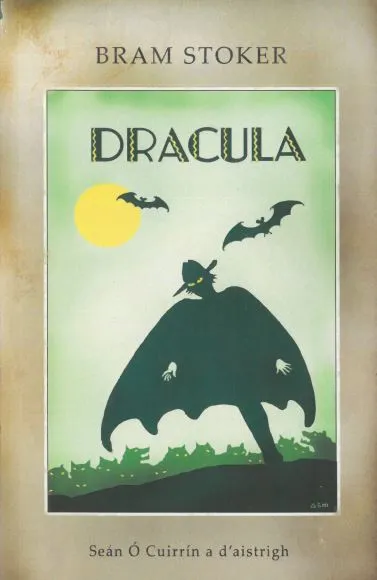
Dracula is an epistolary novel; it is made up of fictional letters and diary entries written by the characters. ↩
The title of this post, Dracula an Lae, is Dracula Daily in Irish. ↩
Pronounced something approximately like ”Shown O’Harker”. Irish does not natively use the letter J and Gaelicisations tend to use a slender s sound in it place, which is similar to an English “sh” sound. ↩
Something like “Meen Nee Woor-ee”. Murray is an Anglicised Gaelic surname in the first place. The male form is Ó Muirí, something like “O Moor-ee”. She of course later in the novel becomes Mín Uí Earcair, “Meen E Arker”. ↩
”Shawn Seward”. ↩
“Lee-sha”. ↩
“Ar-toor”. Once his father dies Artúr inherits the title of Tiarna Godalming. ↩
Perhaps the translator, in 1933, did not wish to have to research (or invent) Irish or native names for Wallachs, Dacians, Magyars, Szekelys and Huns. ↩
Everyone in Ireland in the eighteenth century seeing a rat for the first time: That cunt is French!
Rats were introduced to Ireland around the 1720s and the word for rat and French are the same, a clipping from luch Fhrancach which literally means French mouse.

Vols.: I, II, III, IV, V, VI, VII, VIII, IX, X, XI
Doing another one of these. I still intend on doing rebogs as well and I’ve added some more styling to make reposts stand out from my own words and make a more clear divide between them.
Devereaux digs into the origin of the phrase “bread and circuses”.
So the surface reading seems clear: he is putting the Roman people on blast for letting their authority over public affairs be taken away, usurped by emperors who promise them bread and circuses (we’ll come to if this is an accurate representation of the history in a moment). They used to have all of this power, the power to bestow offices and armies, but now they cower fecklessly in the wake of imperial slaughter and arbitrary rule.
Except, of course – wait a minute – isn’t the theme of this passage that power is an unwise thing to ask for? The theme of the whole poem is that you shouldn’t be asking the gods for these sorts of things!
Also from Devereaux.
Instead, where real armors evolve against threats, fictional armors evolve as a visual language, borrowing the design elements of other fictional armors far more often than they dip into their own historical exemplars, with the result that the whole thing sort of devours itself.
Fiction referencing exclusively other works for fiction rather than looking to the world is something I think about as well from time to time.
Goldwag reviews a book from the man who coined the word “robot”.
The novel starts with Captain van Toch, a Czech sea-captain in the service of a Dutch trading company, stumbling upon an isolated community of giant amphibians in the Dutch East Indies, living on a single tiny island, their numbers culled constantly by sharks. Van Toch realizes that they’re trainable, and extremely intelligent, and has the idea to plant colonies of them across the Pacific to work as pearl divers. After his death, the Pacific Export Company transitions from luxury goods to mass labor, selling newts across the world as an undersea work force capable of hydraulic and maritime engineering, which results in Newts settling most of the world’s coastlines and becoming an integral part of the global economy. “So now we find the salamanders on the road to their finest flowering; but the human world, too, is enjoying unprecedented prosperity. New continental coasts are being feverishly constructed, new dry land is emerging from where shallows used to be; artificial air support islands are springing up in the middle of the ocean.” (Newts, pg. 165). For all the absurdity, however, Čapek treats his topic seriously. We’re given footnotes, citations, discussions of legal dilemmas and cultural disputes, discourse on the economic impact of newt labor and how it affected different nations and groups, taxonomies on newt evolution and biology. It doesn’t feel like a cheap trick or a gimmick because it’s all done with such care.
In short, to acknowledge transmasculinity, a society would have to first admit that manhood—just like womanhood—is a social class and not a ‘natural’ category. Its people would have to acknowledge that the desire for independence and self-actualization exists within all of us and is not, in fact, stored in the balls.
Thorn outlines very well the fundamental ideological problems in the N.H.S. and how trans healthcare is handled that I think apply very well to the H.S.E. here in Ireland as well.
There are even more serious charges. The coroners’ reports into the deaths of Sophie Williams and Alice Litman said lack of gender affirming care contributed to their deaths. That is to say, it is a matter of publicly recorded fact that the NHS’ failure to provide gender affirming care has contributed to the deaths of patients. Nobody at NHS England has resigned or faced consequences.
Of course panic, misinformation, and mistrust take hold in these conditions! Of course people come to believe the NHS are making secret plots behind closed doors! These conditions are entirely of the NHS’ own making. Slapping a famous trans person’s face on a new outreach program does nothing to address them. As I told Colonel Korn, if the NHS wants to increase trust they should start by apologising.
But the Colonel expressed his bind to me the same way every other NHS senior official I’ve spoken to has. The Department of Health and Social Care tells the NHS how they have to spend their money. The mandate they get from the Health Secretary tells them what services they have to commission: if it says “Ten more transplant wards,” they need ten more transplant wards, and that’s that. If it says “Spend £90m pathologizing trans people,” that’s what he has to do.
This point bears underlining: every single person I have spoken to in the NHS- from local GPs to the National bosses- told me they are powerless. There is nobody at any level of the organisation who takes responsibility for the state the service is in and the suffering it is causing. Every single person blames the person above them, even the man at the top.
Followup from the first of these posts.
In my last post, I succesfully made a bluetooth/wifi Magic Wand Plus. Unfortunately, though, I completely bypassed the original Hitachi board, which happens to be where all the buttons and LEDs are attached, so it was only usable remotely. To make the physical controls work again, I could either make my own copy of the Hitachi’s board, with buttons and LEDs in the same places, or somehow reprogram the original board and make it do my bidding.
The first option requires a lot of measuring, which I find really annoying to do. So, let’s hack the Hitachi’s microcontroller!
I love economic forces.
MongoDB’s popularity among managers during its peak was largely down to the idea that you no longer needed a database expert. Just throw the data into the document DB puddle and let your existing less-specialised developers handle it. The promise of the document database during the peak of their hype was that you didn’t need to employ as many specialists.
Electron, PhoneGap, and React Native promised to let companies replace their expensive platform specialists with more commodified generalists.
Standardisation in web development lowers costs, increases predictability, and makes the various browsers more interchangeable. It’s a hedge that reduces the individual market power of each browser, but usually in equal degree while increasing the value of the overall web, leaving each browser vendor better off as a result. Their market share might not increase but they have a bigger cut of a larger pie. Incompatibility tends to drive developers and companies to other platforms, reducing the overall pie.
Standardisation of labour, conversely, does not benefit labour.
Everybody hates A.I! Here’s another reason to.
Whatever happens to Python or pip is likely to eventually happen to more projects or more frequently. I am concerned mostly about maintainers that are handling this in isolation. If they don't know that AI-generated reports are commonplace, they might not be able to recognize what's happening before wasting tons of time on a false report. Wasting precious volunteer time doing something you don't love and in the end for nothing is the surest way to burn out maintainers or drive them away from security work.
Seth Larson
Seeing as I dusted off Pico-8 again recently here’s a little post about doing palette swaps in it.
The concept of a palette swap is drawing something with a different set of colors. It’s a good way to get more mileage out of your PICO-8 sprites. There are a bunch of things you can do with palette swapping
- create variations on a character
- make simple looping animations
- fade in or out of a scene
- simulate day/night cycles
But what does this mean for us as programmers? How do we represent the concept in code?
Technical website bullshit, but something I’ve been meaning to look at setting up for this site too.
Bots I block fall into one of the following categories:
- Bots that only serve to power adtech on other sites. My site has no ads, but I allow bots such as Google’s AdsBot.
- Intellectual property snitches. I forbid robots that scan for plagiarism, trademark/copyright violations, brand protection, etc.
- Robots that power invasive background checks that border on cyberstalking.
- Scrapers that build datasets to train Generative AI (GenAI), such as large language models (LLMs). I don’t block search clients used by GenAI research assistants; I only block scrapers used to train GenAI models.
I used to be one of the people who “corrected” people about the word Gaelic. I am sorry.
The Irish Language was referred to as both Gaelic and Irish until the Republic was formed. “Irish” was mainly used by academics; “Gaelic” was used by the common people.
The Republic chose “Irish” over “Gaelic” for political/nationalistic reasons.
Dahl started an Instagram account in 2023 that parodied tradwife content creators, after her own account was banned by the platform multiple times. Tradwife content (short for “traditional wife) is fetish content, even if the “wife” isn’t showing skin. It’s a fantasy, and always has been, even when it was used to sell ovens to 1960s homemakers.
Kim is the person who taught me that judging a homeless person for wanting to buy alcohol or cigarettes is utter folly. When you’re homeless, the nights are cold, the world is unfriendly, and everything is painfully uncomfortable. Whether you’re sleeping under a bridge, in a tent, or at a shelter, it’s hard to rest easy. You are likely to have injuries or chronic conditions that bother you persistently, and little access to medical care to deal with it. You probably don’t have much healthy food.
In that chronically uncomfortable, over-stimulating context, needing a drink or some cigarettes makes fucking sense. As Kim explained to me, if you’re laying out in the freezing cold, drinking some alcohol may be the only way to warm up and get to sleep. If you’re under-nourished, a few smokes may be the only thing that kills the hunger pangs. And if you’re dealing with all this while also fighting an addiction, then yes, sometimes you just need to score whatever will make the withdrawal symptoms go away, so you can survive.
A cute story about Star Wars: Battlefront.
But it wasn’t just that it was super difficult and took a long time. The hilarious part of all of this is that the fact that there was still a battle going on outside meant that the number one reason we didn’t get to destroy the shield bunker was that the match had ended. The AI armies we were ignoring went on fighting their war and reached a conclusion before we were able to deal enough damage to the damn thing.

Translations area really interesting and fun. I’ve linked before to Twitch translating pokémon names into Welsh and something I’ve played at before is translating Sonic the Hedgehog character names into Irish.
It doesn’t come with quite the same punning potential as pokémon but the way Sonic character names tend to be ordinary nouns makes it interesting to try to translate, especially trying to capture the relationships between certain names or figuring out what to do with the weirder ones.
If the notes column is blank that means the name is just a straightforward calque of the name from English.
| English name | Irish name | Notes |
|---|---|---|
| Sonic the Hedgehog | Sonaċ an Ġráinneog | |
| Shadow the Hedgehog | Scáṫaċ an Ġráinneog | Shadowy. Also the name of the woman who trained Cú Ċulainn. |
| Silver the Hedgehog | Soilseaċ an Ġráinneog | Bright. Chosen to keep the hedgehog alliteration and rhyming going and works as a contrast to Scáṫaċ.1 |
| Miles “Tails” Prower | Myles “Eireabaill” na gCoileáinín | The miles per hour pun doesn’t work in Irish so I changed it to a reference to Myles na gCopaleen. Roughly Myles “Tails” of the Little Puppies. |
| Knuckles the Echidna | Ailt an Eicidneaċ | |
| Amy Rose | Émí Rós | A transliteration. Rós does means rose, though. |
| Rouge the Bat | Deargaḋ an Ialtóg | Rouge, but also blushing or glowing. |
| E-123 Omega | É-123 Óimige | |
| Cream the Rabbit | Uaċtar an Coinín | |
| Cheese the Chao | Cáis an Nord | Chao is obviously a word formed from removing the letter S from chaos. Anord is chaos (and ord is order) and I thought nord sounded better than anor and also that it would be fun than “an nord” would sound a lot like “anord”. |
| Blaze the Cat | Lasraċ an Cat | Flames/Flaming the Cat. |
| Big the Cat | Láidir an Cat | Strong the Cat. Chosen to keep the alliteration between Blaze and Big. |
| Honey the Cat | Lim an Cat | Mil is honey so I am spelling it backwards to keep the cat alliteration going even if that wasn’t actually present in her original name. |
| The Chaotix Detective Agency | An Ġníoṁaireaċt Ḃleaċtaireaċta Anordúileax | Anordúil means chaotic, ‑eaċ is a suffix which forms nouns with the sense of a person connected to the concept and I’ve subbed in an X like in the original name. |
| Charmy Bee | Meallaċ Beaċ | Charming |
| Vector the Crocodile | Veicteoir an Crogall | |
| Espio the Chameleon | Spiair an Caimileon | Spiaire means spy and with the E cut off the end it’s pronounced like “spear” which is cool. |
| The Babylon Rogues | Rógairí na Bablóine | |
| Jet the Hawk | Scaird an Seaḃaċ | |
| Wave the Swallow | Tonn an Ḟáinleog | |
| Storm the Albatross | Stoirm an Albatras | |
| Dr. Ivo “Eggman” Robotnik | Dr. Ivo “Uiḃeaċ” Robotnik | I thought it would work to leave his real name untranslated. Uḃ is egg and ‑eaċ is our favourite noun-forming suffix (or uiḃeaċ can just mean ovate). Fearuḃ or Uḃḟear would be more straightforwardly Eggman but I think that sounds bad. |
| Metal Sonic | Sonaċ Miotail | |
| Orbot | Glóbat | Globe + bot |
| Cubot | Ciúbat | Cube + bot |
It occurs to me just now that Scáṫaċ, Soilseaċ and Sonaċ could also work as translations of the three beam upgrades you get in Metroid Prime 2, considering that the Annihilator Beam is meant to be a sonic weapon. ↩
Rinne mé leaḃarṁarc de leaṫanaċ fánaċ ar Vicipéid.
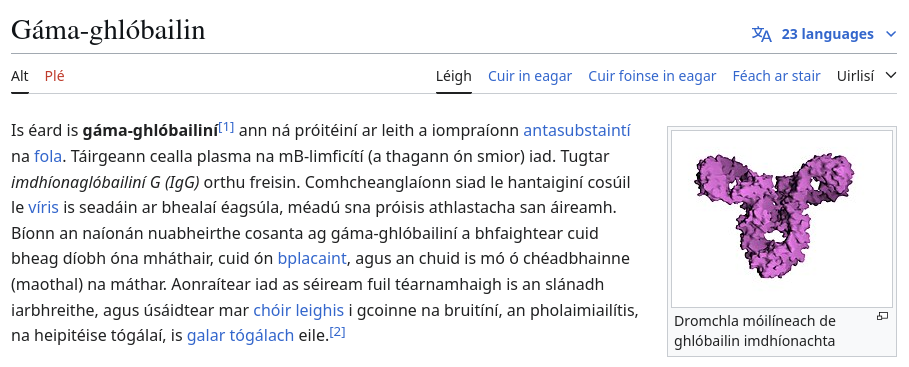
I am glad that the big, official, publically-funded Irish dictionary website has entries like these:


Bhí mé in ann cuid de do radhairc shalacha a thaifeadadh agus tú ag masturbate agus ag teacht ar orgasm.
Níl an ċéad uair í.

This post uses obscure Unicode codepoints and custom fonts which may not display in RSS readers and some browsers.
A few years ago I made a Gaelic-style monospaced pixel font that I called Cló Piocó-8. This was originally just testing out the custom font mode in Pico-8 for fun. I then ended up making a truetype font using Pixel Forge.
If custom fonts can display it looks like this.
This was mainly for fun and I haven’t used it terribly much.
Around the same time I made it I also made a similar pixel font for Ogham. I think the reason for making these separately was because the main font was monospaced but the Ogham one wasn’t? Or perhaps it just didn’t occur to me to include the Ogham section with the original font at the time. Either way I’ve decided I wasn’t happy with them being two separate fonts so I made a new version of Cló Piocó-8 that includes the Ogham block.
I also changed another character: R.
The original R character in the font was more straightforwardly based on an Insular R and looked like this: R.
You might be wondering what an Insular R is.
Because in the middle ages Ireland was a pretty isolated place, and Irish monks were left to their devices, eventually developing a style of writing called Insular script.
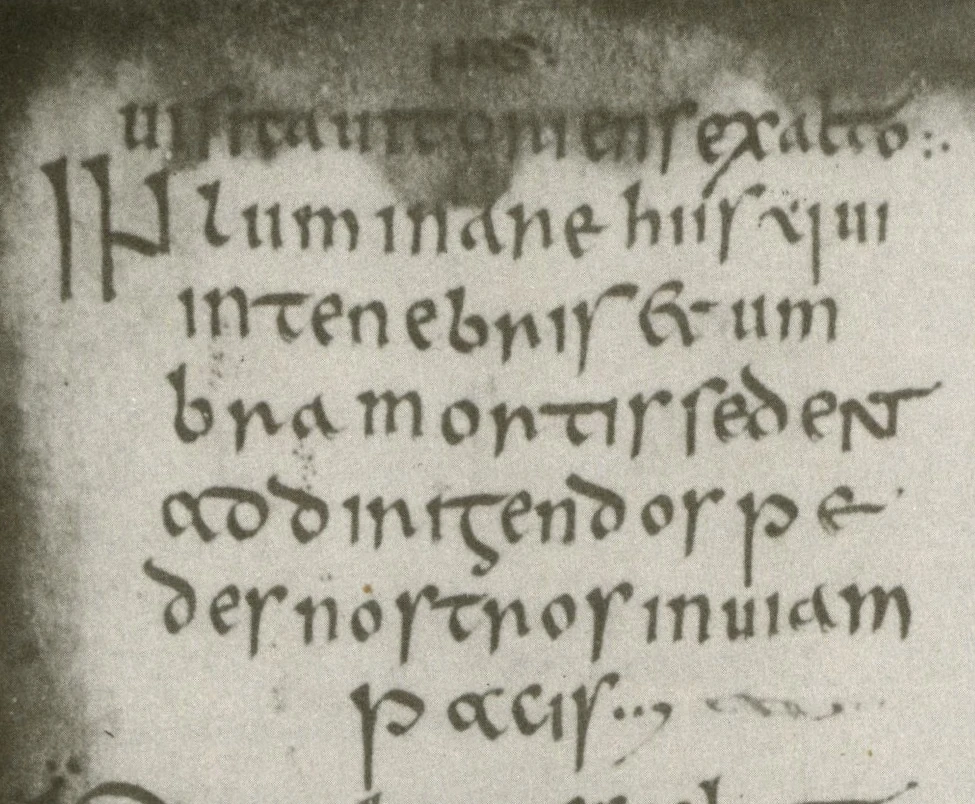
When printing came to Ireland, which took a while, most things were printed in English. Gaeilgeoirí didn’t have much to read (but most of them couldn’t, anyway). The first book printed with an Irish type was Aibidil Gaoidheilge agus Caiticiosma in 1571, using a font which had been commissioned by Elizabeth Tudor, though it was actually a bit of a hodgepodge of Gaelic, Roman and Italic, with the new Gaelic letters resembling the Anglo-Saxon type made by John Day.
Since then Irish has been printed in both Roman and Gaelic type, the former often simply due to practical considerations of the availability or expense of Gaelic fonts or because it was seen as more modern. It is rare to see Gaelic script used now except for in decorative text such as signs and plaques.
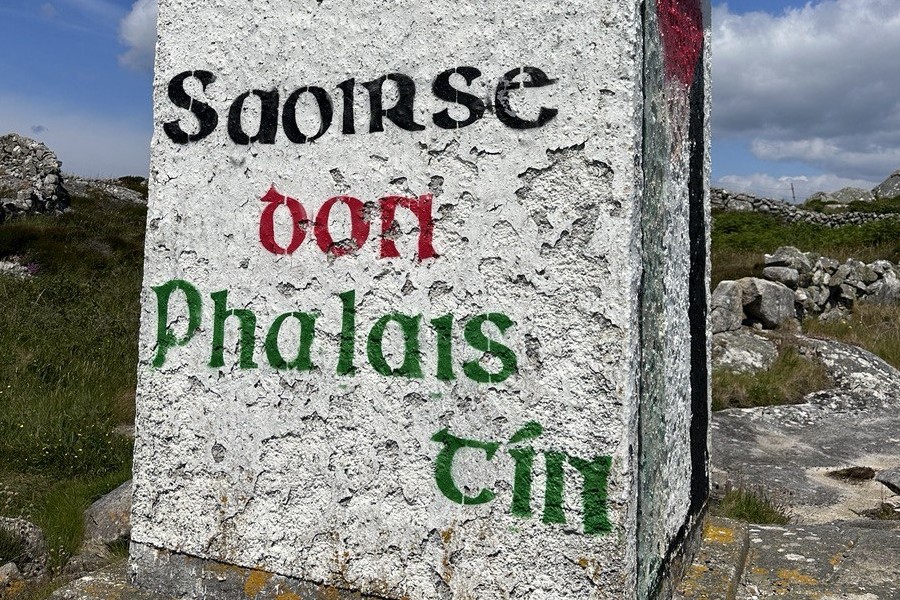
But I quite like the Gaelic-style scripts and—as evidenced by my homepage—I quite like playing with typefaces. I use Mínċló from Gaelċló for most the Gaelic script on this site.
But I will admit there can be some drawbacks to readability. Particularly with f, s and r, or rather their Insular variants, which Unicode has unique codepoints for: ꝼ ꞅ and ꞃ, respectively.
Compared to a Roman f, the Insular ꝼ almost appears as if it has been hammered into the ground like a post. The tail of the character dips below the line and the stroke is level with it, the top of the character only reaching to the same height as a small letter like e. But it is still distinct and recognisable as an f.
The problem starts with s. You might be familiar with a long s, which is basically an old-fashioned way of writing an s where it looks like an f without the stroke in the middle. The Insular ꞅ similarly strongly resembles an Insular ꝼ and if one is more familiar with Roman type it is very easy to confuse them at a glance. Many modern Gaelic typefaces simply use a Roman-style s instead for clarity, or offer the use of both using stylistic sets. I opted to use a Roman-style s when making Cló Piocó-8 for clarity. When your characters are only four characters high you need to be careful about legibility and it’s very common to do this anyway with Gaelic typefaces for both s and r.
But I still, in that first version, decided to go with an Insular ꞃ, a character that resembles a cross between the Insular ꞅ and an n, or perhaps a Greek η with the tail on the other side. In an attempt to make it not look too much like an n I cut one pixel off the right-side, to try and maybe make it look a bit more like a Roman r, but really it just makes it look weird. I left it like that for a long time, but I was never fully satisfied with it.
When I was making my custom cartridge designs for my Pico-8 projects (something else I could write a bog post on, really) I decided to use Cló Piocó-8 to sign my name and the URL of this site on them. This made me have to face that bloody R again. I was never happy with the compromise I made originally and quite frankly people were not going read it as an r. I don’t want anyone typing “oakneef.ie” into their browsers and finding nothing there.
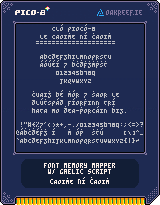
It was here that I came up with my new compromise: R. It is mostly an upper-case Roman R but with a little bit of a tail sticking down for a bit of Insular influence. I have actually started scribbling my r like this when handwriting in Irish as well.
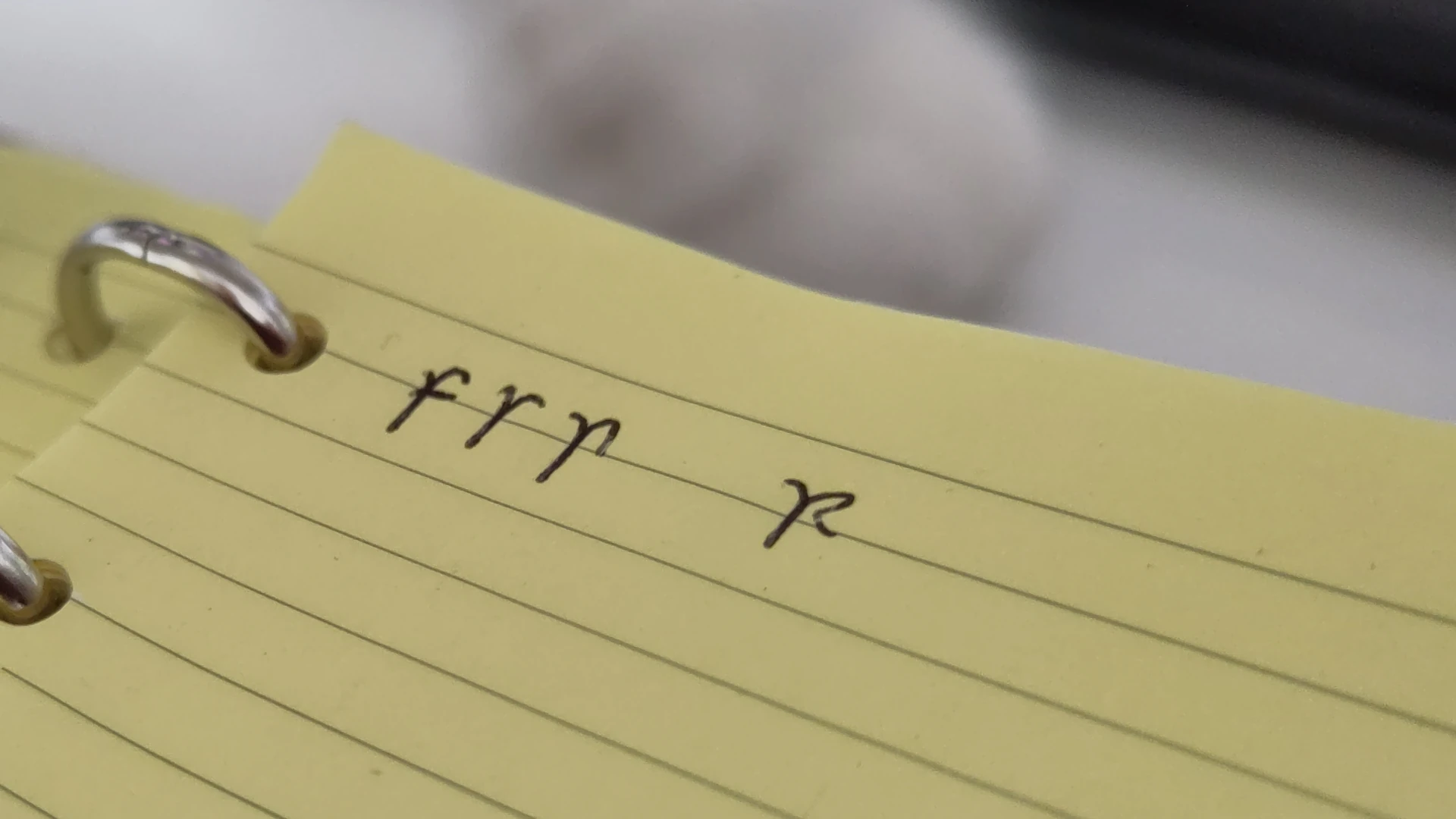
It took me a while to actually bring this change back to the font file itself but when making the 88×31 pixel badge for this site  I was reusing elements from my Pico-8 cartridge design and it reminded me to go back and make the change, and I while doing it I also rolled the Ogham font into it as well, which I had also been intending to do for a while.
I was reusing elements from my Pico-8 cartridge design and it reminded me to go back and make the change, and I while doing it I also rolled the Ogham font into it as well, which I had also been intending to do for a while.
So check out Cló Piocó-8.
| Source Serif 4 | Mínchló Insular-style | Mínchló Roman-style | Cló Piocó-8 v1 | Cló Piocó-8 v2 |
|---|---|---|---|---|
| fsrn | fsrn | fsrn | fsrn | fsrn |
Source for historical claims: The Irish Character in Print: 1571-1923, E.W. Lynam
Is cló aonleiṫid, ceaṫair picteilín ar leiṫead i stíl Gaelaċ é Cló Piocó-8. Rinneaḋ é ar dtús don Pico-8 aċ is féidir a íoslódáil mar cló TTF.
Tá téacs samplaċ i nGaeilge, Gàidhlig, Breatnais ⁊ Oġam ṫíos:
d’Iṫ cat mór duḃ na héisc lofa go pras.
Mus d’fhàg Cèit-Ùna ròp Ì le ob.
Parciais fy jac codi baw hud llawn dŵr ger tŷ Mabon.
᚛ᚐᚃᚔᚈᚑᚏᚔᚌᚓᚄ᚜
As Pixel Forge a rinneaḋ é.
Cló Piocó-8 is a (mostly) monospaced 4 pixel wide typeface in a Gaelic style originally made for the Pico-8 fantasy console, downloadable as a TTF font.
Sample text in Irish, Scottish Gaelic, Welsh and Ogham:
d’Iṫ cat mór duḃ na héisc lofa go pras.
Mus d’fhàg Cèit-Ùna ròp Ì le ob.
Parciais fy jac codi baw hud llawn dŵr ger tŷ Mabon.
᚛ᚐᚃᚔᚈᚑᚏᚔᚌᚓᚄ᚜
Made with Pixel Forge.